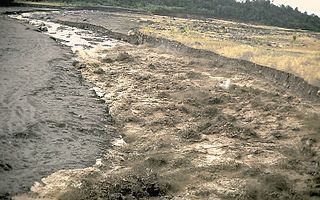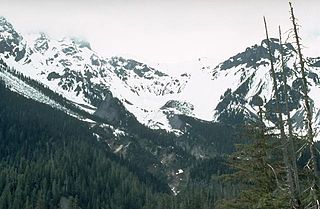Related Research Articles

Montserrat is a British Overseas Territory in the Caribbean. It is part of the Leeward Islands, the northern portion of the Lesser Antilles chain of the West Indies. Montserrat is about 16 km (10 mi) long and 11 km (7 mi) wide, with roughly 40 km (25 mi) of coastline. It is nicknamed "The Emerald Isle of the Caribbean" both for its resemblance to coastal Ireland and for the Irish ancestry of many of its inhabitants. Montserrat is the only non-fully sovereign full member of the Caribbean Community and the Organisation of Eastern Caribbean States.

A pyroclastic flow is a fast-moving current of hot gas and volcanic matter that flows along the ground away from a volcano at average speeds of 100 km/h (30 m/s) but is capable of reaching speeds up to 700 km/h (190 m/s). The gases and tephra can reach temperatures of about 1,000 °C (1,800 °F).

Mount Pelée or Mont Pelée is an active volcano at the northern end of Martinique, an island and French overseas department in the Lesser Antilles Volcanic Arc of the Caribbean. Its volcanic cone is composed of stratified layers of hardened ash and solidified lava. Its most recent eruption was in 1932.

A lahar is a violent type of mudflow or debris flow composed of a slurry of pyroclastic material, rocky debris and water. The material flows down from a volcano, typically along a river valley.

Plymouth is a ghost town and the de jure capital of the island of Montserrat, an overseas territory of the United Kingdom located in the Leeward Island chain of the Lesser Antilles, West Indies.
A pyroclastic surge is a fluidised mass of turbulent gas and rock fragments that is ejected during some volcanic eruptions. It is similar to a pyroclastic flow but it has a lower density or contains a much higher ratio of gas to rock, which makes it more turbulent and allows it to rise over ridges and hills rather than always travel downhill as pyroclastic flows do.

Glacier Peak or Dakobed is the most isolated of the five major stratovolcanoes of the Cascade Volcanic Arc in the U.S state of Washington. Located in the Glacier Peak Wilderness in Mount Baker–Snoqualmie National Forest, the volcano is visible from the west in Seattle, and from the north in the higher areas of eastern suburbs of Vancouver such as Coquitlam, New Westminster and Port Coquitlam. The volcano is the fourth tallest peak in Washington state, and not as much is known about it compared to other volcanoes in the area. Local Native Americans have recognized Glacier Peak and other Washington volcanoes in their histories and stories. When American explorers reached the region, they learned basic information about surrounding landforms, but did not initially understand that Glacier Peak was a volcano. Positioned in Snohomish County, the volcano is only 70 miles (110 km) northeast of downtown Seattle. From locations in northern Seattle and northward, Glacier Peak is closer than the more famous Mount Rainier (Tahoma), but as Glacier Peak is set farther into the Cascades and almost 4,000 feet (1,200 m) shorter, it is much less noticeable than Mount Rainier.

On March 27, 1980, a series of volcanic explosions and pyroclastic flows began at Mount St. Helens in Skamania County, Washington, United States. A series of phreatic blasts occurred from the summit and escalated until a major explosive eruption took place on May 18, 1980, at 8:32 AM. The eruption, which had a Volcanic Explosivity Index of 5, was the most significant to occur in the contiguous United States since the much smaller 1915 eruption of Lassen Peak in California. It has often been declared the most disastrous volcanic eruption in U.S. history.

Mount Unzen is an active volcanic group of several overlapping stratovolcanoes, near the city of Shimabara, Nagasaki on the island of Kyushu, Japan's southernmost main island.

The Soufrière Hills are an active, complex stratovolcano with many lava domes forming its summit on the Caribbean island of Montserrat. After a long period of dormancy, the Soufrière Hills volcano became active in 1995 and has continued to erupt ever since. Its eruptions have rendered more than half of Montserrat uninhabitable, destroying the capital city, Plymouth, and causing widespread evacuations: about two-thirds of the population have left the island. Chances Peak in the Soufrière Hills was the highest summit on Montserrat until the mid-1990s, but it has since been eclipsed by various rising and falling volcanic domes during the recent volcanic activity.

The Other Final is a 2003 documentary film, directed by Johan Kramer of Dutch communications agency KesselsKramer, about a football match between Bhutan and Montserrat, then the two lowest-ranked teams in the FIFA World Rankings. The game was played in the Changlimithang Stadium, Thimphu, Bhutan on the same day as the 2002 FIFA World Cup Final. Bhutan won the game 4–0, their first ever victory and also the first time they had kept a clean sheet in any match. The friendly match, officially sanctioned by FIFA, saw Bhutan rise out of the bottom two of the world rankings and kept Montserrat in last place. The referee was Englishman, Steve Bennett.

In volcanology, an explosive eruption is a volcanic eruption of the most violent type. A notable example is the 1980 eruption of Mount St. Helens. Such eruptions result when sufficient gas has dissolved under pressure within a viscous magma such that expelled lava violently froths into volcanic ash when pressure is suddenly lowered at the vent. Sometimes a lava plug will block the conduit to the summit, and when this occurs, eruptions are more violent. Explosive eruptions can expel as much as 1,000 kg (2,200 lb) per second of rocks, dust, gas and pyroclastic material, averaged over the duration of eruption, that travels at several hundred meters per second as high as 20 km (12 mi) into the atmosphere. This cloud may subsequently collapse, creating a fast-moving pyroclastic flow of hot volcanic matter.

Volcano Mountain is a cinder cone in central Yukon Territory, Canada, located a short distance north of Fort Selkirk, near the confluence of the Pelly and Yukon Rivers. Volcano Mountain is called Nelrúna in the Northern Tutchone language.

The Oruanui eruption of New Zealand's Taupō Volcano was the world's most recent supereruption.

Mount Gareloi, or Gareloi Volcano, is a stratovolcano in the Aleutian Islands of Alaska, United States, about 1,259 miles (2,026 km) from Anchorage. Gareloi is located on Gareloi Island, and comprises most of its land mass. The island also has two small glaciers which protrude to the northwest and southeast.

The Bridge River Vent is a volcanic crater in the Pacific Ranges of the Coast Mountains in southwestern British Columbia, Canada. It is located 51 km (32 mi) west of Bralorne on the northeastern flank of the Mount Meager massif. With an elevation of 1,524 m (5,000 ft), it lies on the steep northern face of Plinth Peak, a 2,677 m (8,783 ft) high volcanic peak comprising the northern portion of Meager. The vent rises above the western shoulder of the Pemberton Valley and represents the northernmost volcanic feature of the Mount Meager massif.

The Montserrat cricket team has represented the British Overseas Territory of Montserrat in cricket. The team is not a member of the International Cricket Council, but the Montserrat Cricket Association is a member of the Leeward Islands Cricket Association, which itself is a member association of the West Indies Cricket Board, and players from Montserrat generally represent the Leeward Islands cricket team at domestic level and the West Indies at international level. Montserrat has however played as a separate entity in matches which held Twenty20 status, but has not appeared in first-class or List A cricket. The team was previously coached by Abdiel Hughes, who was appointed in April 2012. Their former captain was McPherson Meade.

Mount Cayley is an eroded but potentially active stratovolcano in the Pacific Ranges of southwestern British Columbia, Canada. Located 45 km (28 mi) north of Squamish and 24 km (15 mi) west of Whistler, the volcano resides on the edge of the Powder Mountain Icefield. It consists of massif that towers over the Cheakamus and Squamish river valleys. All major summits have elevations greater than 2,000 m (6,600 ft), Mount Cayley being the highest at 2,385 m (7,825 ft). The surrounding area has been inhabited by indigenous peoples for more than 7,000 years while geothermal exploration has taken place there for the last four decades.
The geology of Montserrat formed from the Pliocene into recent times with five major and three parasitic volcanoes. For the most part, the volcanoes only erupted andesite, pyroclastic flows and dome lavas and the Montserrat series is dominantly calc-alkaline. The only exception is South Soufriere Hill with basalt lava flows and pyroclastic flows.

In early January 1951, a series of minor explosions and earthquakes rocked Mount Lamington, a volcano in Oro Province, Territory of Papua and New Guinea. Prior to the eruption, Mount Lamington was not recognized as a volcano due to the absence of historically-recorded eruptions and dense vegetation cover. From January 15, volcanic activity intensified, and tall eruption plumes were generated. The largest eruption occurred on the morning of January 21 when a thick black plume of ash rose 50,000 feet (15,000 m) into the atmosphere. The eruption collapsed a lava dome and produced a lethal pyroclastic flow that killed 2,942 people. In the years after the eruption, new lava domes formed and collapsed in succession. Activity persisted until July 1956. The eruption is the deadliest natural disaster in Australian history, as the region was under the rule of the Government of Australia.